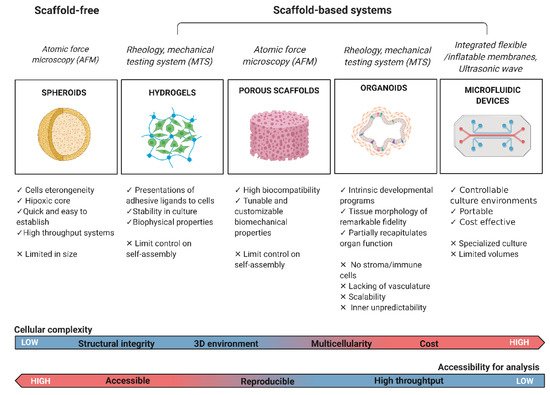Today, tumors are depicted as organs, with a higher complexity compared to normal healthy tissue
[1]. The complexity of a neoplastic disease relies on individual specialized cells within the tumor tissue that sustain the ability of cancer cells to build a flourishing niche in order to grow and spread, called the tumor microenvironment (TME)
[2]. Tumor cells and mesenchymal cells, forming the tumor-associated stroma, collaborate in a multistep process to create the overall tumor tissue (composed of cells and extracellular matrix [ECM]), which is very different from its healthy counterpart in biological, mechanical, chemical, and topographic characteristics
[3][4]. During tumor development, cancer cells and stromal cells remodel the surrounding microenvironment and consequently affect and are affected by both biochemical and biophysical signals derived from it
[5][6]. For example, the biophysical signal derived from changes in ECM stiffness is a solid tumor-specific trigger that enhances epithelial cells to transition into a malignant phenotype
[7]. Alterations in tumor mechanics can derive from imbalances between matrix deposition and degradation
[8][9][10]; increases in matrix crosslinking
[11][12]; defective lymphatic drainage and leaking from blood vessels (increase in oncotic and fluid pressure)
[13][14]; and deregulated growth and high cell densities that generate solid pressure and cell “jamming”, which prevents cell movements
[15][16]. These mechanical signals are transduced into biochemical signals from the cytoskeleton to the nucleus, actively affecting tumor cell behavior (
Figure 1). Biophysical signals are mostly conveyed by membrane-spanning dimers called integrin receptors, which bind to the surrounding ECM and physically bridge them to the cell cytoskeleton, translating mechanical signals into biochemical ones
[17][18][19]. In this way, focal adhesions and integrin receptors serve as biochemical signaling hubs to initiate mechanoresponsive signaling pathways by concentrating and directing signaling proteins involved in cell polarity, response to tensile strength, migration, and invasion
[20][21]. Mechanical signals transduced from the external microenvironment to the intracellular cytoskeleton can be further transmitted into the nucleus, where they can affect nuclear architecture and chromosome and chromatin organization, resulting in both genetic and epigenetic landscape changes
[22]. Analogous to focal adhesions, linkers of nucleoskeleton and cytoskeleton protein (LINC) complexes on the nuclear membrane physically connect the cytoskeleton to the nucleoskeleton
[23][24]. This complex comprises two families: the KASH domain proteins (nesprins) bind to various cytoskeletal constituents, whereas the SUN domain proteins associate with the nuclear lamina (laminins) and nuclear pore complexes (NPCs)
[25]. Laminins connect directly and indirectly through emerin and lamin B receptor (LBR) binding to different regulatory proteins that are involved in chromatin modification, transcriptional regulation, and mRNA processing, and to BAF protein (or BANF1), which binds directly to double-stranded DNA
[26]. These anchor complexes that connect the ECM to the nucleus through the cytoskeleton can alter the DNA regulatory complex activity with consequent changes in chromatin organization
[27], gene transcription
[28], RNA splicing, or chromatin modification
[26][29].


